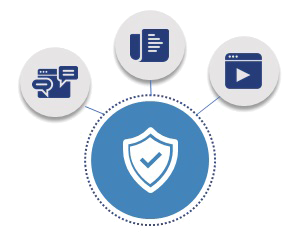IAM Hygiene Best Practices
Written December 6, 2022

Identity & access management (IAM) is a broad field that includes not only tools and technology but also the procedures that establish and manage a digital identity and its access to resources. Traditionally, it has managed human identities, but more often now, it is also managing non-human or 'machine' identities.
IAM is vital to the process of protecting digital assets as it enables proper access to a resource for the appropriate period that is necessary to complete a particular activity. IAM oversees the defining guidelines and regulations that determine which digital identities are granted access to which online resources. A sound IAM strategy, where all identities are managed with consistent policies and technologies that give security executives an awareness of who has access to its resources, is an essential component of good security hygiene.
Why Hygiene Practices are Needed
In recent years, many significant data breach instances have proven that seemingly safe systems are not as secure as we believe they are. This is due to the many variables that contribute to the vulnerability of system access and security. Identity and Access Management is a process that is both complex and essential for controlling information security concerns. Although technology plays a significant role in identity and access management, successful IAM strategies also include procedures and people for onboarding and offboarding users, granting and revoking access, and preventing unauthorized individuals from accessing systems. Once an IAM strategy has been formulated, technologies may be implemented to automate the identity management lifecycle and decrease the number of mistakes that are often caused by human operations.
Regardless of how well the IAM technological solution works; if it's implemented poorly and the processes aren't well thought out, it may leave a company vulnerable to considerable exposure and risk. A component of the comprehensive plan for the governance of IAM is making sure that the appropriate IAM technical solution is implemented. It is very necessary, to keep the organization's security intact, to check that the appropriate personnel have been hired, that the information technology is operating as it should, and that any new systems have been correctly integrated.
Challenges to Proper IAM Hygiene
If appropriate IAM hygiene is not followed, an organization puts itself in jeopardy of various threats. Orphan accounts, accounts that can provide access to corporate systems, services and applications but does not have a valid owner, are the first type, and they are very common. Orphan accounts can be the result of poor practices, such as,
- Too many ways to offboard a user
- Too many sources of users onboarding
- An unclear governance policy for deactivating accounts
- A lack of automation and built-in system audits
- Unclear roles and responsibilities, and more
It's possible that this will lead to compromised accounts which in turn compromises the safety of the entire company.
Permission creep is another typical side effect of poor IAM hygiene. A user is said to be engaging in "permission creep" when they have amassed an excessive number of privileges over the course of their time that is more than what they require to do their job yet continue to cling on to them. This condition sometimes arises when a longer-term employee of a corporation shifts jobs or responsibilities within the organization and is subsequently awarded additional privileges. An example of abuse might be an employee who has more access than they need yet is inclined to use it inappropriately. Second, an attacker who gains access to this type of account also obtains the rights described above.
Last but surely not least is the burdensome upkeep that is caused by repetitive tasks. There are certain activities that cannot be automated since there is either insufficient time (and/or knowledge) or the time invested isn't worthwhile. When discussing the burdensome nature of maintenance in IAM, non-automated, repetitive work is the primary example that comes to mind. If appropriate IAM hygiene is not followed, it is common for more repetitions to be necessary. Consequently, human error occurs, which leads to inconsistent profiles, incorrectly set groups, and inadequate GPO implementations.
Top hygiene best practices
In the modern world of information technology, IAM must encompass both on-premises and cloud access to data and systems that are classified and categorized. Additionally, it is required to enable corporate access policies, which are used to ensure secure access for many remote users who operate via public and private networks. Because of this, an organization may experience several difficulties during the phases of creating, deploying, and administering an IAM system. All these issues may be overcome if adequate attention is paid to them throughout the life cycle of the IAM solution.
The following are some essential actions that will assist you in ensuring that your firm is adhering to appropriate IAM hygiene:
- Conduct an IAM assessment to gain a better understanding of the present condition of the organization's pain points and gaps, and then implement ideas and best practices into the IAM program to enhance it.
- Perform a review of the current IAM infrastructure, identifying any gaps and implementing necessary updates to the annual IAM architectural audit.
- Conduct regular access reviews (either semi-annually or yearly) of the environment to verify that individuals only have access to the resources that they require to perform their jobs and nothing else.
- Establish an RBAC/ABAC program, assign roles to your staff members, and make access permissions available or unavailable based on a user's position within the business.
How to get started
If you haven't carried out an IAM review in a while, beginning there is recommended. If you have previously carried out an assessment, you should proceed with next steps to ensure that you are continually examining the data and looking for ways to improve.
If you want to learn about IAM or are just starting out, KeyData can help. Identity and Access Management is KeyData's most important service. We put a lot of our energy into IAM. Our people and our knowledge are what give us an edge at KeyData. Our team is made up of highly skilled engineers and consultants who specialize in Identity Governance and Administration, Identity Access Management, Privileged Access Management, Customer Identity, and Cloud Security Posture Management. Our team has a strong track record of providing end-to-end IAM services, from gathering requirements and making roadmaps to full implementation, training, and managed support. Don't be afraid to contact us right away for a free first meeting.
References:
https://blog.pan-net.cloud/posts/identity-management-hygiene/
https://www.linkedin.com/pulse/brush-your-teeth-hygiene-identity-access-management-firdaus-modak/





